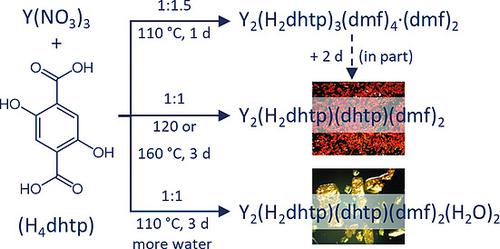当前位置:
X-MOL 学术
›
Z. Anorg. Allg. Chem.
›
论文详情
Our official English website, www.x-mol.net, welcomes your feedback! (Note: you will need to create a separate account there.)
Variability in the Formation and Framework Polymorphism of Metal‐organic Frameworks based on Yttrium(III) and the Bifunctional Organic Linker 2,5‐Dihydroxyterephthalic Acid
Zeitschrift für anorganische und allgemeine Chemie ( IF 1.4 ) Pub Date : 2020-11-25 , DOI: 10.1002/zaac.202000276 Pascal D. C. Dietzel 1 , Richard Blom 2 , Helmer Fjellvåg 3
Zeitschrift für anorganische und allgemeine Chemie ( IF 1.4 ) Pub Date : 2020-11-25 , DOI: 10.1002/zaac.202000276 Pascal D. C. Dietzel 1 , Richard Blom 2 , Helmer Fjellvåg 3
Affiliation

|
Depending on the solvothermal reaction conditions, we obtained three different metal‐organic frameworks with yttrium(III) as metal component and 2,5‐dihdyroxyterepthalic acid (H4dhtp) as bifunctional organic linker: Y2(H2dhtp)3(dmf)4·(dmf)2 (CPO‐29) contains dinuclear, paddle‐wheel like inorganic secondary building units (SBUs) connected by the organic linker to a network with α‐Po topology, while Y2(H2dhtp)(dhtp)(dmf)2 (CPO‐30) and Y2(H2dhtp)(dhtp)(dmf)2(H2O)2·(H2O)4 (CPO‐31) contain one‐dimensional inorganic SBUs that differ in how the half‐ and fully deprotonated ligands are connected to and arranged around them. Only the carboxylic acid groups of the organic linker are deprotonated in CPO‐29, while CPO‐30 and CPO‐31 contain both 2,5‐dihydroxyterephthalate (H2dhtp2–) linkers and fully deprotonated 2,5‐dioxidoterephthalate (dhtp4–) linkers. All three compounds contain large volumes filled with solvent, but we were able to demonstrate permanence of porosity only for CPO‐30. Variable temperature powder X‐ray diffraction reveals that CPO‐29 and CPO‐31 undergo discontinuous phase transitions upon heating, and the flexibility of the framework structure indicated by these might be the reason for the inability to access the pore volume. Desolvated CPO‐30 and CPO‐31 are polymorphs, whose network structures differ in whether the H2dhtp2– and dhtp4– linkers are located in cis or trans arrangement around the inorganic SBU.
中文翻译:

基于钇(III)和双功能有机连接基2,5-二羟基对苯二甲酸的金属有机骨架的形成和骨架多态性的变异性
根据溶剂热反应条件,我们获得了三种不同的金属有机骨架,其中钇(III)为金属组分,而2,5-二乙氧基对苯二甲酸(H 4 dhtp)作为双官能有机连接基:Y 2(H 2 dhtp)3(dmf )4 ·(dmf)2(CPO-29)包含双核桨状无机二级建筑单元(SBU),通过有机连接器连接到具有α-Po拓扑的网络,而Y 2(H 2 dhtp)(dhtp )(dmf)2(CPO-30)和Y 2(H 2 dhtp)(dhtp)(dmf)2(H 2 O)2 ·(H 2 O)4(CPO-31)包含一维无机SBU,它们在半去质子化和完全去质子化的配体之间的连接和排列方式不同。在CPO‐29中,仅有机连接基的羧酸基团被去质子化,而CPO‐30和CPO‐31既包含2,5-二羟基对苯二甲酸酯(H 2 dhtp 2-),又具有完全去质子化的2,5-二氧化对苯二酸酯(dhtp 4) –)链接器。所有这三种化合物都含有大量充满溶剂的化合物,但我们仅能证明CPO-30的孔隙率持久。可变温度粉末X射线衍射表明,CPO-29和CPO-31在加热时会经历不连续的相变,这些所指示的骨架结构的柔韧性可能是无法进入孔体积的原因。去溶剂化的CPO-30和CPO-31是多晶型物,其网络结构在H 2 dhtp 2–和dhtp 4–接头位于无机SBU周围是顺式还是反式排列方面都不同。
更新日期:2021-01-14
中文翻译:

基于钇(III)和双功能有机连接基2,5-二羟基对苯二甲酸的金属有机骨架的形成和骨架多态性的变异性
根据溶剂热反应条件,我们获得了三种不同的金属有机骨架,其中钇(III)为金属组分,而2,5-二乙氧基对苯二甲酸(H 4 dhtp)作为双官能有机连接基:Y 2(H 2 dhtp)3(dmf )4 ·(dmf)2(CPO-29)包含双核桨状无机二级建筑单元(SBU),通过有机连接器连接到具有α-Po拓扑的网络,而Y 2(H 2 dhtp)(dhtp )(dmf)2(CPO-30)和Y 2(H 2 dhtp)(dhtp)(dmf)2(H 2 O)2 ·(H 2 O)4(CPO-31)包含一维无机SBU,它们在半去质子化和完全去质子化的配体之间的连接和排列方式不同。在CPO‐29中,仅有机连接基的羧酸基团被去质子化,而CPO‐30和CPO‐31既包含2,5-二羟基对苯二甲酸酯(H 2 dhtp 2-),又具有完全去质子化的2,5-二氧化对苯二酸酯(dhtp 4) –)链接器。所有这三种化合物都含有大量充满溶剂的化合物,但我们仅能证明CPO-30的孔隙率持久。可变温度粉末X射线衍射表明,CPO-29和CPO-31在加热时会经历不连续的相变,这些所指示的骨架结构的柔韧性可能是无法进入孔体积的原因。去溶剂化的CPO-30和CPO-31是多晶型物,其网络结构在H 2 dhtp 2–和dhtp 4–接头位于无机SBU周围是顺式还是反式排列方面都不同。


























 京公网安备 11010802027423号
京公网安备 11010802027423号